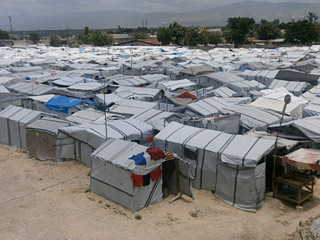Human Rights Center recommends to UN ways to improve protections in refugee camps
Contact: Andrea Lampros
Human Rights Center communications manager
510.847.4469 or 510.643.7215, alampros@berkeley.edu

dozens of camps for Haitians rendered homeless
after the 2010 earthquake.
In a seminal series of new reports for the Office of the UN High Commissioner for Refugees (UNHCR), the Human Rights Center at the University of California, Berkeley, School of Law, offers the first in-depth look at safe shelter options for survivors of sexual violence in refugee camps and displacement settings worldwide.
“Where do you hide a safe house in a refugee camp—where everyone is out in the open under the same sun? It’s a complex and urgent task to keep survivors of sexual and gender-based violence safe in the temporary camps erected during crises, but we must do it and do it well,” said Kim Thuy Seelinger, director of the Sexual Violence Program at the Human Rights Center (HRC) and lead author of the reports. Seelinger presented the center’s global findings at the UNHCR’s annual NGO consultation in Geneva on June 11, 2013.
Four reports examine shelters in Haiti, Kenya, Colombia, and the Thailand/Burma border. A fifth comparative report summarizes the unique challenges that shelter-providers face, as well as strategies for protecting and serving refugees and internally displaced persons in camps and urban areas. The reports, which were requested by the UNHCR, also include recommendations for improved security and call attention to protection gaps that leave many male and LGBT survivors especially vulnerable.
Seelinger and her team will return to the case study countries throughout June to share information and recommendations with local shelter providers and government representatives.
Across the globe, rape and sexual torture are committed during periods of armed conflict or natural disaster. However, the risk of sexual and gender-based violence continues for many even once they have fled to a refugee or internal displacement camp. Providing protection in these insecure settings, where resources are scarce, can be tremendously challenging.
In meeting with survivors, service providers, local officials, and aid agencies on four continents, researchers found that steps can be taken worldwide to increase the physical and psychosocial safety of survivors. Researchers also found that every community has particular needs, making a one-size-fits-all model impossible.
“We hope that this research will inform policy shifts on the global level as well as increase collaboration among service providers within the countries studied,” said Julie Freccero, Sexual Violence Program Officer at the Human Rights Center.
All country reports, the comparative report, and one-page summaries can be found online here.